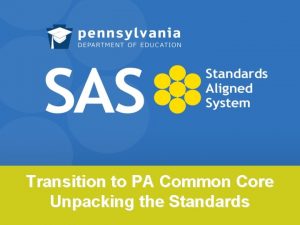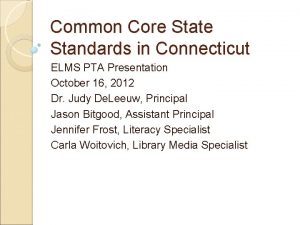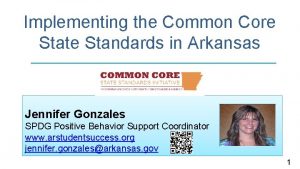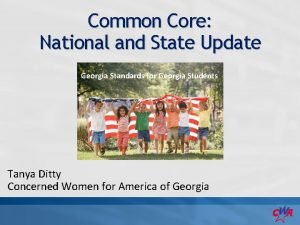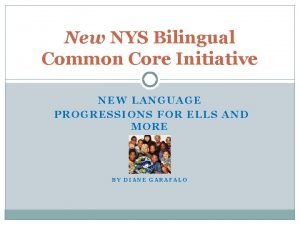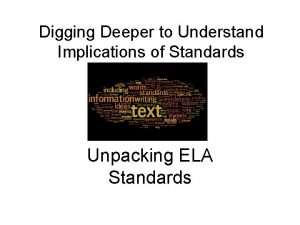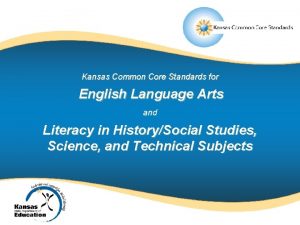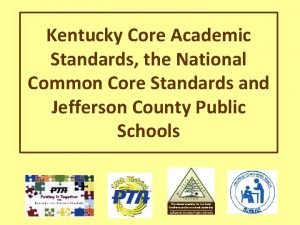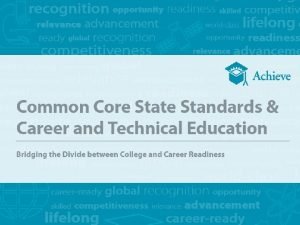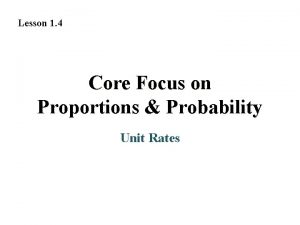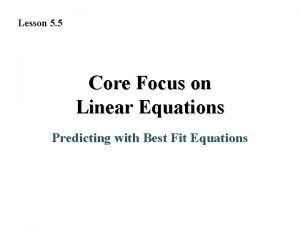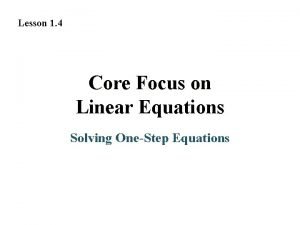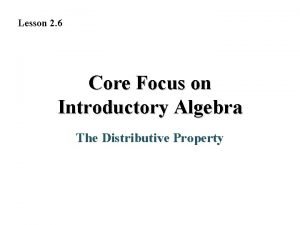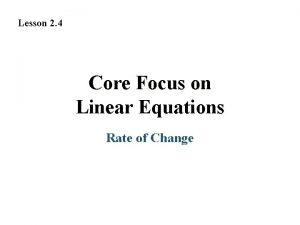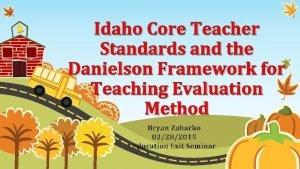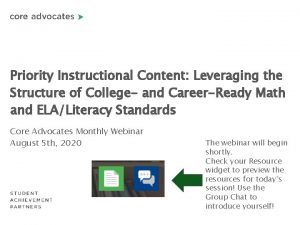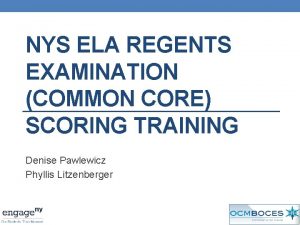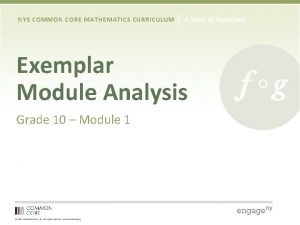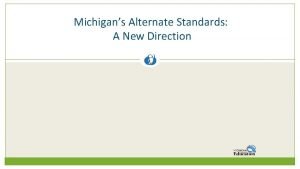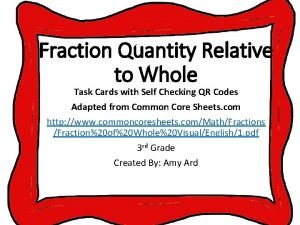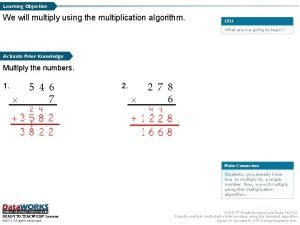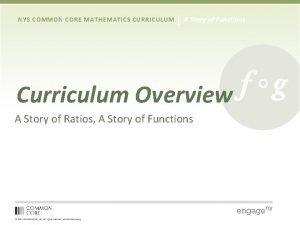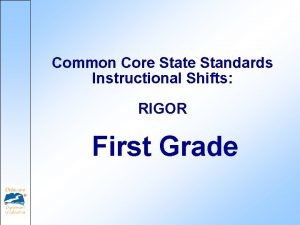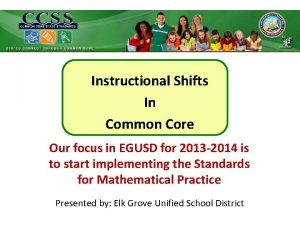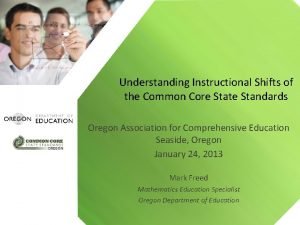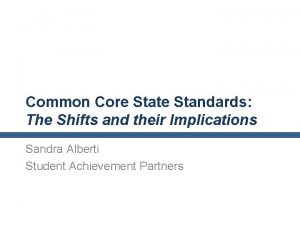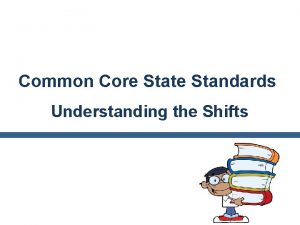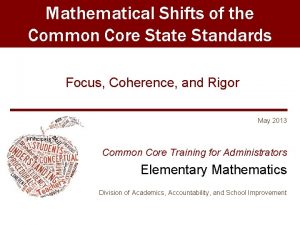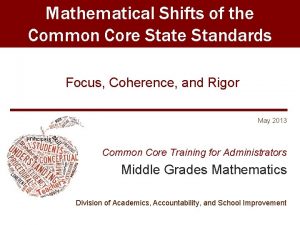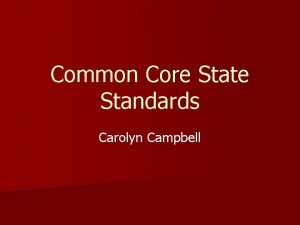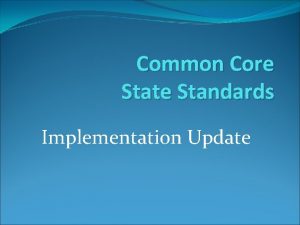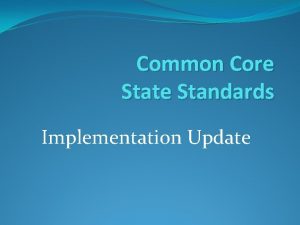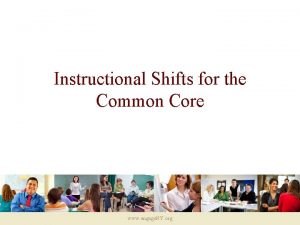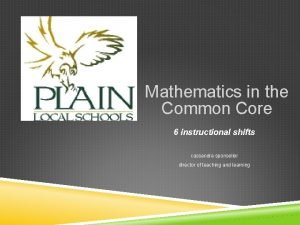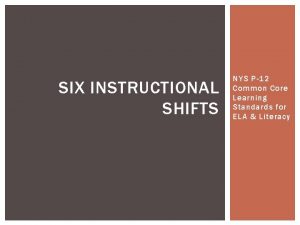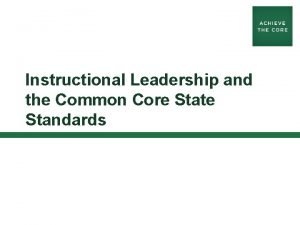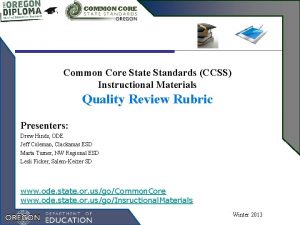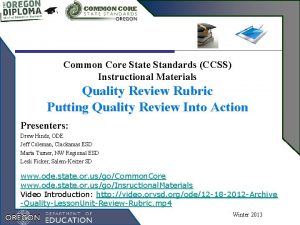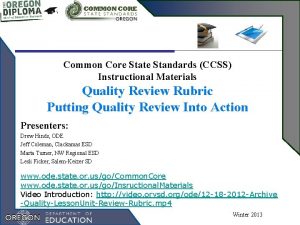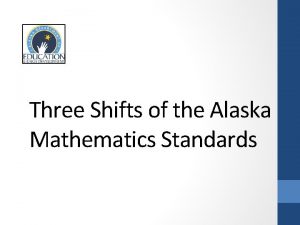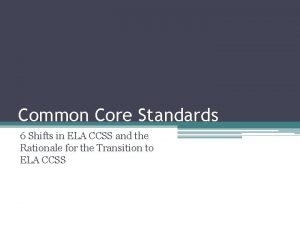Common Core State Standards Instructional Shifts FOCUS First






































- Slides: 38

Common Core State Standards Instructional Shifts: FOCUS First Grade

CCSS-Mathematics Overview

What I already know about the Common Core State Standards. What I would like to learn about the Common Core State Standards. What I learned today about the CCSS and how I can apply this knowledge in my classroom. Focus

Overview of the CCSS http: //engageny. org/resource/common-core-in-mathematics-overview

Why Common Core? Initiated by the National Governors Association (NGA) and Council of Chief State School Officers (CCSSO) with the following design principles: • Result in College and Career Readiness • Based on solid research and practice evidence • Fewer, higher and clearer


What The Disconnect Means for Students • Nationwide, many students in both 2 and 4 year colleges need remediation in math. • Students who take remedial classes have lower odds of finishing their degree or program.

Common Core State Standards for Mathematics: Three Key Shifts

CCSS Shifts Background 1. Focus: Focus strongly where the standards focus. 2. Coherence: Think across grades, and link to major topics. 3. Rigor: In major topics, pursue conceptual understanding, procedural skill and fluency, and application.

The Why: Shift One Focus strongly where the Standards focus • Significantly narrow the scope of content and deepen how time and energy is spent in the math classroom. • Focus deeply on what is emphasized in the standards, so that students gain strong foundations.

The Why: Shift Two Coherence Think across grades, and link to major topics within grades • Carefully connect the learning within and across grades so that students can build new understanding onto foundations built in previous years. • Begin to count on solid conceptual understanding of core content and build on it. Each standard is not a new event, but an extension of previous learning.

The Why: Shift Three Rigor In major topics, pursue conceptual understanding, procedural skill and fluency, and application • The CCSSM require a balance of: • Solid conceptual understanding • Procedural skill and fluency • Application of skills in problem solving situations • This requires equal intensity in time, activities, and resources in pursuit of all three.

A Closer Look at: Focus

CCSS: Focus http: //engageny. org/resource/common-core-in-mathematics-shift-1 -focus

Focus • Move away from "mile wide, inch deep" curricula identified in TIMSS • • • Learn from international comparisons Teach less, learn more “Less topic coverage can be associated with higher scores on those topics covered because students have more time to master the content that is taught” – Ginsburg et al. , 2005

The shape of math in A+ countries 16 Mathematics topics intended at each grade by at least two-thirds of A+ countries 1 Schmidt, Mathematics topics intended at each grade by at least two-thirds of 21 U. S. states Houang, & Cogan, “A Coherent Curriculum: The Case of Mathematics. ” (2002).

Traditional U. S. Approach K Number and Operations Measurement and Geometry Algebra and Functions 17 Statistics and Probability 12

Math Common Core Standards Progressions K-12 K 1 2 3 4 5 6 7 8 9 -12 Counting and Cardinali ty Number and Operations in Base Ten Number and Operations: Fractions Operations and Algebraic Thinking Number and Quantity Ratios and Proportional Relationships The Number System Expressions Algebra and Equations Functions Geometry Measurement and Data Statistics and Probability

The Hunt Institute http: //www. youtube. com/watch? v=2 rje 1 NOg. HWs&list=UUF 0 pa 3 n. E 3 a. ZAf BMT 8 pq. M 5 PA&index=18&feature=plcp

Focus in Math Focus deeply on only those concepts that are emphasized in the standards. • Enable students to gain a conceptual understanding of math to ensure a strong foundation. • Make certain students have a high degree of procedural skill and fluency. • Ensure their ability to apply the math they know to solve problems inside and outside the math classroom. •

Prioritize Standards • Not all Standards are created equal

Key Areas of Focus in Mathematics Grade Focus Areas in Support of Rich Instruction and Expectations of Fluency and Conceptual Understanding K– 2 Addition and subtraction – concepts, skills, and problem solving and place value 3– 5 Multiplication and division of whole numbers and fractions – concepts, skills, and problem solving

Required Fluencies in K-6 Grade Standard Required Fluency K K. OA. 5 Add/subtract within 5 1 1. OA. 6 Add/subtract within 10 2. OA. 2 Add/subtract within 20 (know single-digit sums from memory) 2 3 2. NBT. 5 3. OA. 7 3. NBT. 2 Add/subtract within 100 Multiply/divide within 100 (know single-digit products from memory) Add/subtract within 1000 4 4. NBT. 4 Add/subtract within 1, 000 5 5. NBT. 5 Multi-digit multiplication 6 6. NS. 2, Multi-digit division 6. NS. 3 Multi-digit decimal operations

Focus in First Grade

Domains Numbers and Operations in Base Ten (NBT) • Operations and Algebraic Thinking (OA) • Measurement and Data (MD) • Geometry (G) •

NBT- Example Use place value understanding and properties of place value to add and subtract. NC CCSS 1 st grade Unpacked

OA- Example Represent and solve problems involving addition and subtraction. NC CCSS 1 st grade Unpacked

MD- Example Measure lengths indirectly and by iterating length units. NC CCSS 1 st grade Unpacked

G- Example Measure lengths indirectly and by iterating length units. NC CCSS 1 st grade Unpacked

Fluency • Add and subtract within 10

Group Discussion

Shift One: Focus strongly where the Standards focus Question One: “Why focus? There’s so much math that students could be learning, why limit them to just a few things? ”

Shift One: Focus strongly where the Standards focus Question Two: “What are the four domains that are the focus in first grade? Kindergarten has one additional focus. What is that domain?

Shift One: Focus strongly where the Standards focus Question Three: “Why are some clusters focused upon more heavily than others, in particular in First Grade? How does this impact your planning of lessons for the school year with your students?

Shift One: Focus strongly where the Standards focus Question Four: “How does looking at the examples of CCSS-M Unpacked at the First Grade level help to clarify your understanding of the focus of the Common Core State Standards?

What I already know about the Common Core State Standards. Focus What I would like to learn about the Common Core State Standards. What I learned today about the CCSS and how I can apply this knowledge in my classroom.

Resources • www. corestandards. org • http: //ime. math. arizona. edu/progressions/ • www. insidemathematics. org • www. teachingchannel. org • www. achievethecore. org • www. illustrativemathematics. org • commoncoretools. me

Next Steps?
 Unpacking common core standards
Unpacking common core standards Connecticut common core state standards
Connecticut common core state standards Common core state standards missouri
Common core state standards missouri Common core state standards arkansas
Common core state standards arkansas Common core standards georgia
Common core standards georgia New language arts progressions
New language arts progressions Unpack common core
Unpack common core Kansas state standards ela
Kansas state standards ela Kcas standards
Kcas standards Common career technical core
Common career technical core Focus on form vs focus on forms
Focus on form vs focus on forms Integrated cost leadership/differentiation strategy
Integrated cost leadership/differentiation strategy Cost leadership strategy
Cost leadership strategy Actor focus vs object focus
Actor focus vs object focus Core focus on linear equations
Core focus on linear equations Core focus on proportions and probability answer key
Core focus on proportions and probability answer key Core focus on linear equations
Core focus on linear equations Core focus on linear equations
Core focus on linear equations Core focus on introductory algebra
Core focus on introductory algebra Rate of change
Rate of change The brittle, rocky outer layer of earth
The brittle, rocky outer layer of earth Compare and contrast the crust mantle and core
Compare and contrast the crust mantle and core Which layer is the least dense
Which layer is the least dense Core rigidity
Core rigidity National core standards 2020
National core standards 2020 Idaho core standards
Idaho core standards Idaho core teacher standards
Idaho core teacher standards Achieve the core priority standards
Achieve the core priority standards Utah core math standards
Utah core math standards Factors necessary for appropriate service standards
Factors necessary for appropriate service standards Essential elements of state
Essential elements of state Nys ela regents argument rubric
Nys ela regents argument rubric Nys common core mathematics
Nys common core mathematics Michigan essential elements
Michigan essential elements Common core sheets.com
Common core sheets.com Common core institute
Common core institute 4th grade math jeopardy common core
4th grade math jeopardy common core Common core lattice multiplication
Common core lattice multiplication Whats common
Whats common
